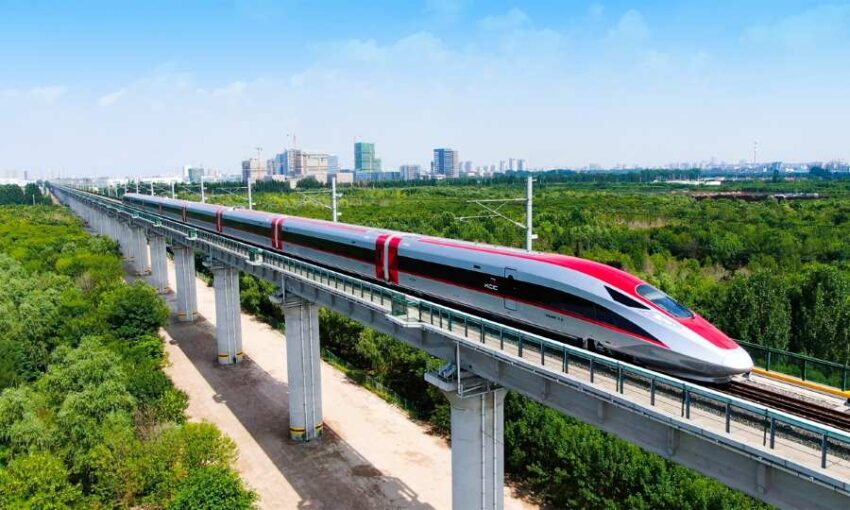China’s Railway Passenger Traffic Hits Record High in Jan-May 2025
China's railway network handled 1.86 billion passenger trips in the first five months of 2025, setting a new record, according to official data.
In the first five months of 2025, China’s railway network has achieved an unprecedented milestone, handling 1.86 billion passenger trips. This marks a significant year-on-year increase of 7.3%, setting a new record for the same period in history, according to official data released by the China State Railway Group Co., Ltd. The national railway operator has been instrumental in this achievement, with China’s railways continuing to expand and modernize to meet the growing demands of both domestic and international travelers.
Record-Breaking Passenger Traffic in 2025
Throughout January to May, China’s rail system saw an average of 11,243 train trips being operated daily. This represents a 7.5% year-on-year increase, a clear reflection of the rise in both commuter and leisure travel across the country. The period’s peak traffic occurred during the May Day holiday, a key travel period in China, where rail operators recorded 13,752 train trips and over 23 million passenger departures on May 1 alone. This represents the highest single-day numbers for both train trips and passenger departures in the country’s history, showcasing the incredible demand for rail travel during peak periods.
China’s railway network has been a vital component of the country’s transportation infrastructure, serving a population of over 1.4 billion people. It facilitates not only commuting for work, education, and business but also leisure travel across some of the most picturesque destinations in the world. With its vast network of high-speed and conventional rail lines, it has become a crucial part of daily life for millions and a key enabler of China’s growing tourism industry.
Growth of Foreign Passenger Traffic
One of the most significant trends observed in 2025 has been the notable increase in foreign nationals using China’s rail system. With the government’s push to expand visa-free policies for foreign nationals, there has been a surge in international travel to China, particularly in the realm of train travel. In the first five months of 2025, foreign nationals accounted for 7.67 million passenger trips, marking a 29% increase compared to the same period in 2024. This upward trend demonstrates the growing popularity of China as a tourist destination and the appeal of its expansive rail system for foreign visitors.
One particularly significant development has been the rapid growth of cross-border rail travel. The China-Laos Railway, which has been operational for several years, recorded 124,000 passenger trips in the first five months of 2025, a substantial increase of 24.2% compared to the previous year. This railway line has become an important corridor for both tourism and trade, connecting China with Southeast Asia and making travel more convenient for international visitors to explore regions that were previously less accessible by rail.
Tourist Trains and New Rail Services
To cater to the increasing demand for leisure travel, China’s railway authorities have rolled out a variety of specialized services aimed at enhancing the travel experience for tourists. One of the standout offerings has been the introduction of tourist-specific trains, designed to meet the needs of leisure travelers who seek comfort, convenience, and new experiences. In 2025, 630 customized tourist trains have been launched, reflecting a 20.2% increase from the previous year. These specialized trains focus not only on leisure tourism but also cater to wellness tourism, which is growing in demand in the post-pandemic era.
Many of these tourist trains are linked to popular destinations in China, such as the scenic areas of Guilin, Zhangjiajie, and the Tibetan Plateau. These areas are known for their breathtaking landscapes and historical significance, making them major tourist attractions for both domestic and international visitors. The introduction of tourist trains helps to provide a seamless, comfortable travel experience for tourists while also reducing the environmental impact of travel through the use of more energy-efficient rail transport compared to cars or airplanes.
Additionally, these trains are equipped with high-end services, including premium dining, entertainment options, and wellness amenities, ensuring that passengers enjoy a luxurious and relaxing journey. This is particularly appealing to elderly travelers or those looking for a more comfortable, less stressful way to explore China’s vast and diverse landscapes. The railway system’s focus on the “silver economy” has made train travel more accessible and enjoyable for senior citizens, a demographic that increasingly seeks to travel and experience new cultures in their later years.
Technological Advancements and Accessibility Enhancements
The Chinese government and railway authorities have also been focusing on technological advancements and service enhancements to meet the needs of modern travelers. The 12306 ticketing platform, which serves as the primary portal for booking train tickets, has undergone continuous updates. Features such as discounts for senior passengers, flexible ticket options, and quieter compartments for those seeking a peaceful journey have been introduced. Furthermore, facial recognition technology is being deployed at major train stations, allowing passengers to bypass traditional ticket checks and seamlessly enter the train stations. These technological improvements enhance the passenger experience and streamline the overall travel process, making it more efficient and convenient.
Moreover, accessibility for passengers with special needs has been a key focus. Railway stations are being equipped with ramps, elevators, and specialized seating arrangements to ensure that elderly passengers, individuals with disabilities, and families with children can travel with ease and comfort. Train carriages designed specifically for seniors have been integrated into long-distance routes, providing a more comfortable environment for elderly passengers.
China’s Railway as a Catalyst for Economic Growth and Tourism
China’s vast and modern railway system is a major driver of the country’s economy. As one of the largest infrastructure projects in the world, the rail network plays a critical role in facilitating the movement of people and goods, contributing to regional development, and supporting the burgeoning tourism sector. The growth of the railway network has directly supported other industries, such as tourism, retail, and hospitality, by making remote destinations more accessible to tourists and improving regional connectivity.
Rail travel has also become a more sustainable alternative to air and car travel, aligning with China’s goals for reducing carbon emissions and promoting green development. The government has committed to expanding its high-speed rail network further, including international connections like the China-Laos Railway, which enhances its standing as a global transportation hub. With future plans to increase the total length of high-speed rail lines and further integrate technology into rail services, China’s railway system will continue to be an essential part of the country’s infrastructure for years to come.
Conclusion
China’s record-breaking railway passenger traffic in 2025 highlights the growing demand for rail travel, driven by the nation’s expanding infrastructure, increasing foreign tourism, and a broader push for sustainable, comfortable transportation options. The railway system has become a central part of China’s social and economic fabric, offering millions of passengers a reliable and efficient way to travel while supporting the growth of key industries such as tourism and retail. As the country looks to the future, the expansion of rail services, the introduction of specialized tourist trains, and improvements in accessibility will ensure that China’s railways remain a vital part of its economic and cultural landscape.
With continued innovation and service enhancements, China’s railway system is well-positioned to meet the challenges of a growing and increasingly mobile population, while also accommodating the needs of international travelers. As rail travel continues to rise in popularity, both domestically and globally, China is poised to lead the way in modern rail transportation.
The post China’s Railway Passenger Traffic Hits Record High in Jan-May 2025 appeared first on Travel and Tour World


